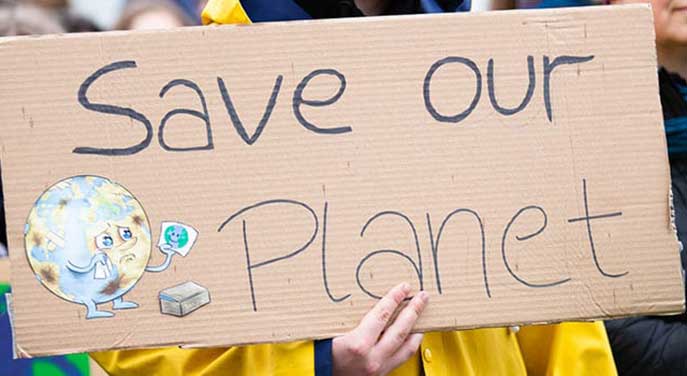 The media is filled daily with dire stories about COVID-19. Is there anything good coming out of this pandemic?
The media is filled daily with dire stories about COVID-19. Is there anything good coming out of this pandemic?
Beyond the sadness and unease, some benefits will positively impact our lives and the health of the environment.
The most obvious environmental benefit is that travel has diminished significantly across the globe. Tens of thousands of airline flights flooded the sky daily until recently and billions of people commuted to work. Now much of the world is shut down and people are staying home, working remotely where possible.
It hasn’t been accurately measured but clearly the impact from the reduction in greenhouse gas emissions is tremendous. Tens of thousands of tonnes of CO2 are not being released, so the negative impacts on climate must likewise be reduced. Some sources report that CO2 emissions are down 25 per cent on average in urban centres around the world.
Reports out of China, the U.S., and Italy and other parts of Europe show that airborne pollutants, particularly nitrous oxide (NO2), have declined by up to 50 per cent. In Rome, NO2 levels are down by about 30 per cent. The European Environment Agency reported this week that NO2 levels in one province in Italy have declined by 47 per cent over the same time last year. Across China and Italy, levels are down by 10 to 25 per cent.
Numbers weren’t readily available for American states particularly hard hit by COVID-19. But in New York, Washington State, Louisiana and California, indications are that NO2 levels have similarly declined.
The decline in NO2 levels alone may save the lives of tens of thousands of people around the world who would otherwise succumb to respiratory issues.
Another effective indicator of atmospheric health is PM2.5, which measures particulate matter in the air. It’s reportedly down about 25 per cent in many urban centres. This means air is cleaner and easier for people and animals to breathe. Most of these declines are attributed to reduced travel by gas-powered vehicles and reduced industrial outputs.
Additionally, Róisín Commane, an assistant professor in the Department of Earth and Environmental Sciences at Columbia University in New York, says carbon monoxide levels have dropped by an astonishing 50 per cent, mostly due to reduced vehicle traffic.
In Venice, Italy, you can see fish and plants in the canal water for the first time in decades, since boat traffic is virtually halted. I was there in November and at that time the waters were murky and litter-filled.
However, we need to be careful not to overstate or believe everything we read. For instance, unfounded claims have been circulating about wildlife returning to the canals. Many of these claims have been false and sensationalized. In fact, the recovery and return of wild things takes time.
However, any improvement is a good outcome.
In China, the Standing Committee of the National People’s Congress (NPC) has temporarily banned the trade and consumption of wild animals. The ban covers the hunting, trading and transport of all terrestrial wild and captive-bred animals for human consumption. This is an attempt to limit man’s exposure to animals that could carry viruses we haven’t previously encountered.
Once the pandemic is resolved, there’s a growing call for China to make the ban permanent. Other countries are lagging behind but need to do likewise.
Ecologists around the globe have been studying the movement of wildlife from natural habitats to exotic animal breeding facilities and markets for decades.
As we continue to invade new areas of the globe to exploit resources, we upset the natural balance. As we enter these areas, and ultimately transport once-isolated species to new habitats for breeding or slaughter, we allow viruses to transfer between species – with devastating results.
Pathogens can and will move from host species to humans. The evidence is in various disease outbreaks, from Ebola to the Black Plague to COVID-19.
UN Environment Programme executive director Inger Andersen says that the way we exploit the planet’s resources makes it easier for “pathogens to pass from wild and domestic animals to people.”
The more opportunities we create for this to happen, the more likely it is that a new virus-linked pandemic will arise.
In many markets, such as the one at Wuhan, China, where COVID-19 originated, animals are kept alive and butchered on the spot. That means the pathogens remain viable and are easily transmitted between species. The viruses can then mutate and interfaces to humans are created.
We can always be hopeful, but it may well be business as usual once the pandemic is over. The struggles we face today will quickly be forgotten as we strive to rebuild our lives and the economy.
But for now, nature is the beneficiary and we can only hope it lasts.
And in the meantime, we can spend much more time enjoying our neighbourhoods and yards, gaining a greater appreciation of how diverse our little patch can be.
So go outside – while maintaining social distancing – and enjoy your little part of the world!
Geoff Carpentier is a published author, expedition guide and environmental consultant. Visit Geoff online at www.avocetnatureservices.com, on LinkedIn and on Facebook.
The views, opinions and positions expressed by columnists and contributors are the author’s alone. They do not inherently or expressly reflect the views, opinions and/or positions of our publication.

